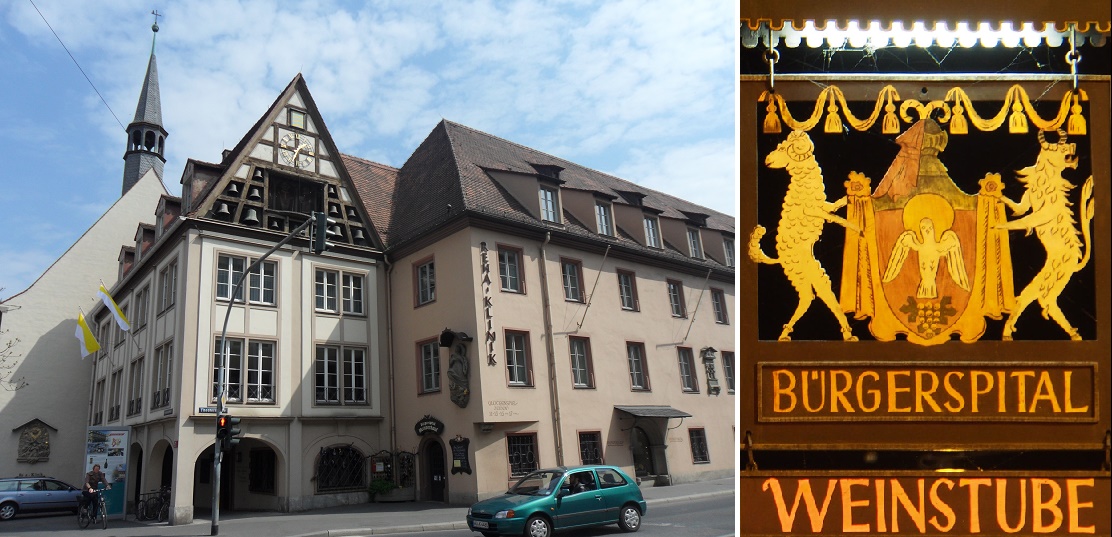Historic estate in the German wine-growing region of Franconia in the city of Würzburg with the full name "Bürgerspital zum Heiligen Geist". The Würzburg patrician Johannes von Steren (1270-1329) made an estate at the current location available for the admission of people in need of care and thus established the foundation. The "New Hospital" (later renamed the "Citizens' Hospital") was officially founded in 1316, which was confirmed in a document by Pope John XXII (1244-1334) in 1320. This makes the estate one of the oldest wineries in Germany and Europe. The founding family pledged 13 acres of vineyards as security. Over the centuries, it grew to its present size.

The picture on the left shows the Bürgerspital with the church, the wine tavern with restaurant (where the wines are served) and the rehabilitation clinic; the picture on the right shows the tavern sign of the wine tavern with the symbol of the Holy Spirit.
Vineyards
The vineyard is owned by the "Foundation under public law". It is managed by Robert Haller as administrator; Elmar Nun is the cellar master and Karl Brand is the oenologist. The vineyards cover 120 hectares of vines. Of these, 80% are located within the Würzburg city limits in the single vineyards Abtsleite, Innere Leiste, Pfaffenberg and Stein with the Stein-Harfe in sole ownership. There are further shares in the single vineyard sites Marsberg, Pfülben and Teufelskeller (Randersacker), Sonnenschein (Veitshöchheim), Scharlachberg (Thüngersheim) and Kapellenberg (Frickenhausen).
Grape varieties & wine cellars
Unusually for the Franconian wine-growing region, Riesling is the most common variety, accounting for almost a third (30 ha), followed by Silvaner (27 ha), Müller-Thurgau (10 ha), Bacchus,Pinot Bl anc, Pinot Noir, Pinot Gris, Rieslaner, Domina, Gewürztraminer, Scheurebe and Blaufränkisch. The vineyards are densely planted. Natural viticulture with restrictive fertilisation is practised. The wine cellar, which is one of the largest in Germany, has a capacity of two million litres of wine and contains over 200 oval oak barrels with a capacity of 700,000 litres. The best qualities of Riesling, Silvaner and Pinot varieties are fermented in these barrels and then matured on the lees. The red wine varieties are generally matured in wooden barrels.
Wines
They are then bottled in the famous Bocksbeutel with the unmistakable Bürgerspital shoulder crest (the Bürgerspital is considered the "birthplace" of this special bottle shape). Wines from four centuries are stored in the Bürgerspital cellar, the oldest being a Würzburger Stein from 1540, a bottle of which was tasted by wine author Hugh Johnson in 1961 (i.e. at the age of 421 years) and found to be "still alive". A wine from this vineyard was one of Johann Wolfgang von Goethe 's (1749-1832) favourite wines. Another lover of Stein wines was the writer Kurt Tucholsky (1890-1935). The annual production is around 850,000 bottles. The winery is a founding member of the VDP (Verband Deutscher Prädikatsweingüter) and the Association of European Foundation Wine Estates.
Bürgerspital: by Aarp65 - Own work, CC BY-SA 3.0, Link
Wine bar: by Hajotthu, CC BY-SA 3.0, Link
Voices of our members

The wein.plus encyclopaedia is a comprehensive, well-researched reference work. Available anytime and anywhere, it has become an indispensable part of teaching, used by students and myself alike. Highly recommended!
Dominik Trick
Technischer Lehrer, staatl. geprüfter Sommelier, Hotelfachschule Heidelberg